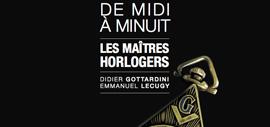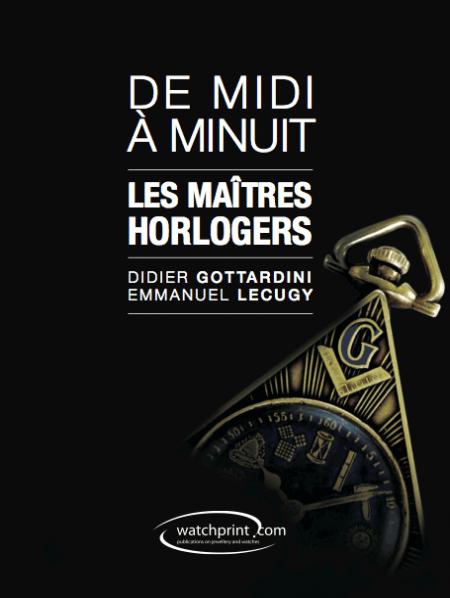A book about the art of watch-making in Freemasonry
What are these often rare and unique Masonic watches’ Who were they made by and why’ Why a book on such a subject’
Maybe just to simply inform one on how the art of watch-making has transgressed through the imagination, the human genius and skills applied to the decorative arts with the aim of offering Freemasons timepieces that match them to the core, by both their simplicity and inner beauty.
Didier Gottardini tell us much more:
Is it because Freemasonry in its rites, evolves within a temporality speci?c than the Freemasons maintain a special relationship with time’
“From noon to midnight…” is the time spent for daily duties in lodges, as such the notion of time passing is highly symbolic for any Mason, and has no bearing on the development of the inner self. In any event, among all objects of everyday life to which were added Masonic symbols, as many links between life in the lodge and in the outside world, we find watches and clocks, both in the United Kingdom and on the Continent, from the end of the Eighteenth century to the present day. If today, the mass produced wristwatches have simplified and standardized their presentation, including Masonic watches, they were a very rare and often unique object, the result of Independent workshops that expressed the intimate relationship between the master watchmaker and his work.
The “footprint” of a Masonic timepiece can reveal itself in different ways. Masonic symbols can appear (often on the dial), sometimes accompanied by such a motto such as “Love your fellow man. Lend him a helping hand”) or “Fortitude, justice, temperance and prudence.” The casing of the watch may also have masonic symbols, either by etching (The pelican on seven steps, the columns of the Temple of King Solomon, the blazing star, the beaming eye, stars, Masonic tools compass bracket etc.) or by his dedication to a “worthy brother” or by its shape (triangular).
Alternative option : The watches can be chiselled with Masonic tools (Compass, square, perpendicular etc.) displayed on the watch itself. These are real “Hidden Beauties” of watchmaking that enlighten the Freemasonry, as these are rare and desirable pieces thanks to their exclusivity.
At the origin of these watches were the watchmakers themselves, whom were masons and tailored these items for their mason brothers across the world.
Very early on, Americans and English masons have generated their early own pendulum decorated with Masonic symbols. Watchmakers such as George Bread-belt (circa 1811-1833 ), and Silas Hoadley who was a mason and often considered as one of the best producer of pendulum in the USA (circa 1820-1840). Across the Atlantic, we also find many so-called “grandfather” pendulum with the arms of the Knights Templars dating from early 18th century.
One of these famous mason watchmakers undoubtedly is Sir Seth Thomas. He is at the origin of watches and clocks that are commonly found in Masonic museums worldwide.
Pocket watches are also often made by masons watchmakers. The best known of them is the brother WW.Dudley who was a great Master Knight Templar. He created any Masonic watches including a highly sought after model by collectors; the famous watch with the skeleton movement decorated with Masonry tools. This piece was sold for $ 40 in white gold and $ 75 in solid gold in the catalogue of the famous Macoy’s store in 1939 (which was also offering Masonic supplies at the time).
One can also find pieces created by Lord Elgin, watches signed Tiffany’s, Tavannes or Waltham with Masonic dials. Wrist watches, for their part, rarely abhorred Masonic decorations. Nevertheless, some models are available on the market such as those manufactured by the brand Cervine or Hamilton. Each movement, dial or casing are to be deciphered according to the different rites: The Ark Royal, Emulation, EBITDA (Scottish Rite Accepted), RER (Rectified Scottish Rite), the French Rite, the Memphis Mizraim, etc.
But in general, the technical work is often identical, and the most common symbols are: Columns, temples or mason tools such as the square, compass, hammer, trowel, scissors or other universal Masonry symbols such as the flamboyant star, the bright delta (triangle), the beaming eye, the letter G, the abbreviation A.L.G.D.G.A.D.L.U. (A Glory From Great Architect Of The Universe), interlaced chains, the swords, the stars, the acacia leaf, the skull, the mosaic pavement or any symbols of Anglo-Saxon masonry such as the Ark Royal or Noah’s Ark.
Unfortunately, the original documents are rare and difficult to find. Older models are equally rare and difficult to find. Most original models are in museums (eg Patek Philippe Museum in Geneva, the Museum of “Villers le lac”, the Museum of watchmaking of “Morteau), in museums of different obedience (such as GODF, GLNF and GLNA) or finally in private museums such as Beyer in Zurich and in private collections.
Nevertheless one can still come across them sporadically in auctions of Antiquorum, Christie’s, Sotheby’s, Bonhams, Auktionen Dr. H.Crott. The Masonic watch has become a rare commodity and difficult to find. The market is full of copies and all kind of cons.
The craze and the inaccessibility of these watches led some to create identical copies made with pieces of old famous watches. It is essential to establish the truth about this subject. Too many watches are sold as Masonic watches on the internet or in auctions. This subject must be discussed with honesty.
The real watches are seeing their value on the rise over time as it has become difficult to find original pieces.
As for historical watches that belonged to famous Masons, price are constantly on the increase and recent sales have reached “sky-high” prices. Still today watches of incredible historical value are hidden away in private collections, so many unique and rare pieces to be discovered by true collectors.
Book only available in french but soon in english
“ De midi à minuit : Les maîtres horlogers “
de Didier Gottardini & Emmanuel Lecugy.
EUR : 79 – CHF : 95
256 pages
on Watchprint.com

